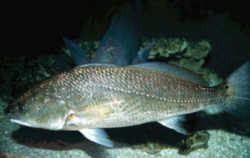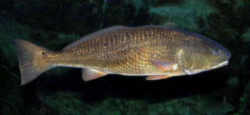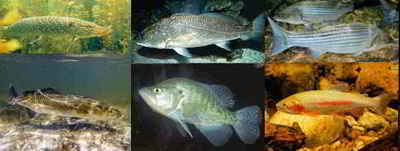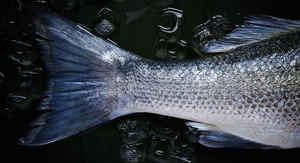
Texas Symbols
Texas State Saltwater Fish
Red Drum

(Sciaenops ocellatus)
Adopted on June 17, 2011.
The red drum became the official saltwater fish of the State of Texas when Governor Rick Perry signed House Concurrent Resolution No. 133 on June 17, 2011. State Representative Dennis Bonner brought with him a proposal to name the red drum (known as redfish by many Texans) the official state saltwater fish.
The redfish was held in high esteem by saltwater fishermen in part do to its remarkable "come-back" after years of commercial overfishing. In order to save the redfish along the Texas Gulf Coast, the Gulf Coast Conservation Association, founded in 1977 by fourteen recreational fishermen, managed to get laws passed banning the sale of redfish. The ban on the sale of redfish caused commercial enterprises to look elsewhere for profits. With the ban on commercial fishing, tightened recreational fishing regulations, saltwater fishing stamps, a saltwater hatchery, and the support of avid redfish anglers up and down the Texas Coast, redfish began to repopulate Texas coastal waters.
Texas State Saltwater Fish: Red Drum

The red drum (Sciaenops ocellatus), also known as channel bass, redfish, spottail bass or simply reds, is a game fish that is found in the Atlantic Ocean from Massachusetts to Florida and in the Gulf of Mexico from Florida to Northern Mexico. It is the only species in the genus Sciaenops. The red drum is a cousin to the black drum (Pogonias cromis), and the two species are often found in close proximity to each other; they can interbreed and form a robust hybrid, and younger fish are often indistinguishable in flavor.
Other Names
Redfish, Rat Red, Bull Red, Or Just "Red"
Characteristics of the Red Drum
The most distinguishing mark on the red drum is one large black spot on the upper part of the tail base. Having multiple spots is not uncommon for this fish but having no spots is extremely rare. The color of red drum ranges from a deep blackish, coppery color to nearly silver. The most common color is reddish-bronze. Red drum is a fast growing fish reaching approximately 11 inches and one pound in its first year, 17-22 inches and 3 1/2 pounds in two years, and 22-24 inches and 6-8 pounds in three years. The record red drum was 94 pounds and was caught on the East coast. The current Texas record is 59 1/2 pounds.
Life History
For the first three years of their lives red drum live in the bays or in the surf zone near passes. Evidence from tag returns show that they remain
in the same area and generally move less than 3 miles from where they were tagged. As they mature, they move from the bays to the Gulf of Mexico where
they remain the rest of their lives, except for infrequent visits to the bays. Although there is little evidence of seasonal migrations, anglers find
concentrations of red drum in rivers and tidal creeks during the winter. Daily movement from the shallows to deeper waters is influenced by tides and
water temperatures. During the fall, especially during stormy weather, large adult red drum move to the gulf beaches, possibly for spawning, where
they can be caught from piers and by surf anglers. This is known as the "bull redfish run."
Young red drum feed on small crabs, shrimp, and marine worms. As they grow older, they feed on larger crabs, shrimp, small fish, and sometimes their
cousins, the Atlantic croaker. They generally are bottom feeders but will feed in the water column when the opportunity arises. A phenomenon called "tailing"
occurs when the red drum feed in shallow water with their head down in the grass and the tail exposed to the air. Predators include humans, birds,
larger fish, and turtles.
Between the third and fourth year, the red drum reaches sexual maturity. Spawning season is from mid-August through mid-October in Gulf waters, near
the mouths of passes and shorelines. Eggs incubate for 24 hours. Larvae are carried into tidal bays by the current. They move to quiet, shallow water
with grassy or muddy bottoms to feed on detritus (dead or decomposing plant and animal matter). The oldest recorded red drum was 37 years old!
During spawning, red drum males attract females by producing a drum-like noise by vibrating a muscle in their swim bladder. They sometimes swim in
water so shallow that their backs are exposed.
Red drum are related to black drum, spotted seatrout, weakfish, mullets and croakers, most of which also make drumming sounds. Scientists believe that
the black spot near their tail helps fool predators into attacking the red drum's tail instead of their head, allowing the red drum to escape.
Habitat
Red drums prefer shallow waters (1-4 feet deep) along the edges of bays with submerged vegetation such as seagrasses. They are found over all bottom types but they seem to prefer areas with submerged vegetation and soft mud. These fish are also commonly found around oyster reefs. Breaks in continuity of shorelines such as coves, points, jetties, old pier pilings, and guts attract them. They prefer soft mud along jetties, pier pilings and jetties. They are often found in water so shallow that their backs are exposed while swimming. During cold spells large numbers of red drum can be found in tidal creeks and rivers. They can live in fresh water and have been found many miles upriver.
Distribution
Red drum range from Massachusetts to Key West, Florida, and along the Gulf Coast to Tupxan, Mexico.
Texas House Concurrent Resolution No. 133
Filed on April 7, 2011, Rep. Bonner's House Concurrent Resolution No. 133 called for the adoption of the red drum (redfish) as the "official State Saltwater Fish of Texas."
H.C.R. No. 133
HOUSE CONCURRENT RESOLUTION
WHEREAS, The lands and waters of Texas are home to a diverse range of animals, and a select number of these species have been recognized as official
state symbols as a result of their significance to our history and culture; and
WHEREAS, A particularly rich natural environment is found along the Texas Gulf Coast, and of the many distinctive plants and wildlife found in that
region, the red drum (Sciaenops ocellatus) is particularly deserving of recognition; and
WHEREAS, Also known as the redfish and the bull red, this majestic saltwater fish spends the first three years of its life in bays along the coast
before heading into the open waters of the Gulf of Mexico; it also demonstrates the hardiness and adaptability so often found in the Lone Star State,
swimming up rivers on occasion and also taking up residence in certain inland reservoirs; and
WHEREAS, Perhaps the most distinctive characteristic of the fish is its Texas-sized stature; at three years of age, the typical red drum is two-and-a-half
feet long and will grow larger over the course of its long life; the biggest red drum caught in Texas waters was 54.25 inches long and weighed nearly
60 pounds; and
WHEREAS, The fish's size, along with its power, speed, and delicious flavor, has made it one of the most popular game species in Texas waters; whether
wading through the shallows, casting with fly rods, or trying their luck in pier or surf fishing, anglers of all types prize the red drum as a catch;
as a result, the fish plays an important role in boosting recreational tourism; and
WHEREAS, In decades past, redfish also helped drive the state's commercial fishing industry and at times made up as much as 35 percent of its landings;
overfishing and illegal netting took a toll, however, and by the early 1980s the drum population had dropped to dangerously low levels throughout the
Gulf of Mexico; fortunately, state officials responded to the situation by enacting legislation and adopting wise management and enforcement measures,
including the development of a revolutionary hatchery; today, numbers have rebounded to the point where the state has one of the best red drum fisheries
in the nation; and
WHEREAS, An environmental success story as well as an awe-inspiring and much-sought-after resident of the Gulf Coast waters, the red drum is a celebrated
member of our natural world, and it is indeed a fitting symbol of the Lone Star State; now, therefore, be it
RESOLVED, That the 82nd Legislature of the State of Texas hereby designate the red drum as the official State Saltwater Fish of Texas.
Texas Law
The red drum was named the official saltwater fish of the State of Texas by House Concurrent Resolution and is not, therefore, listed
in the Texas Statutes.
Only a few of Texas' myriad symbols were actually adopted by an act of the legislature and written into the Texas Statutes.
Taxonomic Hierarchy: Red Drum
Kingdom: Animalia - animals
Phylum: Chordata - chordates
Subphylum: Vertebrata - vertebrates
Class: Actinopterygii - ray-finned and spiny rayed fishes
Subclass: Neopterygii
Order: Perciformes, perch-like fishes
Family: Sciaenidae
Genus: Sciaenops
Species: Sciaenops ocellatus







